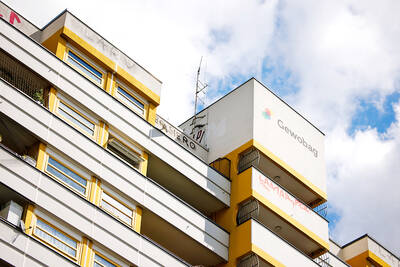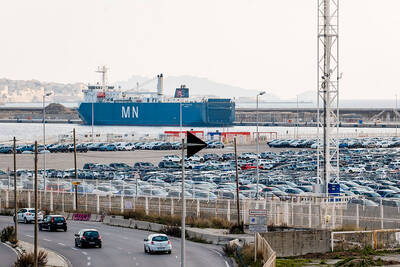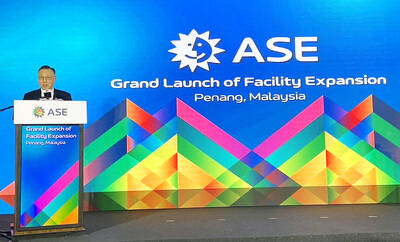China’s industrial firms saw their profits drop last month for a fourth straight month, on track for the sharpest annual decline since records began in 2000.
Industrial profits at large Chinese companies fell 7.3 percent last month compared to a year earlier, the National Bureau of Statistics said in a statement yesterday. That compares with a Bloomberg Economics forecast for a decline of about 6 percent.
While easing from the double-digit declines in the three previous months, the drop deepened a slide in profits this year to a 4.7 percent decrease over the first 11 months, putting the year on track to be the worst on record for industrial businesses.

Photo: AFP
The results suggest Beijing’s most extensive efforts to revive the economy since the pandemic have had a limited effect in lifting demand. Industrial profits are a vital gauge of the financial health of factories, mines and utilities, shaping their investment decisions in the months to come.
Yu Weining (于衛寧), an NBS statistician, credited the recent stimulus measures for narrowing the profit declines, citing improvements in mining and manufacturing sectors.
“As policies continued to take effect, industrial profits continued to narrow the decline and efficiency improved,” Yu said, adding that the government would further implement pro-growth measures announced at the recent Central Economic Work Conference in Beijing.
A program to subsidize upgrades of household appliances and business equipment boosted profits in the relevant sectors, the NBS said, adding that manufacturers of household cleaning appliances saw profits rise 311.4 percent last month.
Corporate finances have come under pressure as China contends with weak domestic demand and its longest stretch of deflation since 1999. Producer prices remain depressed, and retail sales were weaker last month.
While signs of a tentative recovery have emerged, and China is expected to hit its growth target of about 5 percent this year, new challenges are arising as US president-elect Donald Trump prepares to take office next month.
Trump’s threat of steep tariffs on Chinese goods would further disrupt the country’s export sector, which is already facing increased trade barriers from places such as the EU.

Taiwan Semiconductor Manufacturing Co (TSMC, 台積電) yesterday said that its investment plan in Arizona is going according to schedule, following a local media report claiming that the company is planning to break ground on its third wafer fab in the US in June. In a statement, TSMC said it does not comment on market speculation, but that its investments in Arizona are proceeding well. TSMC is investing more than US$65 billion in Arizona to build three advanced wafer fabs. The first one has started production using the 4-nanometer (nm) process, while the second one would start mass production using the

When an apartment comes up for rent in Germany’s big cities, hundreds of prospective tenants often queue down the street to view it, but the acute shortage of affordable housing is getting scant attention ahead of today’s snap general election. “Housing is one of the main problems for people, but nobody talks about it, nobody takes it seriously,” said Andreas Ibel, president of Build Europe, an association representing housing developers. Migration and the sluggish economy top the list of voters’ concerns, but analysts say housing policy fails to break through as returns on investment take time to register, making the

‘SILVER LINING’: Although the news caused TSMC to fall on the local market, an analyst said that as tariffs are not set to go into effect until April, there is still time for negotiations US President Donald Trump on Tuesday said that he would likely impose tariffs on semiconductor, automobile and pharmaceutical imports of about 25 percent, with an announcement coming as soon as April 2 in a move that would represent a dramatic widening of the US leader’s trade war. “I probably will tell you that on April 2, but it’ll be in the neighborhood of 25 percent,” Trump told reporters at his Mar-a-Lago club when asked about his plan for auto tariffs. Asked about similar levies on pharmaceutical drugs and semiconductors, the president said that “it’ll be 25 percent and higher, and it’ll

CHIP BOOM: Revenue for the semiconductor industry is set to reach US$1 trillion by 2032, opening up opportunities for the chip pacakging and testing company, it said ASE Technology Holding Co (日月光投控), the world’s largest provider of outsourced semiconductor assembly and test (OSAT) services, yesterday launched a new advanced manufacturing facility in Penang, Malaysia, aiming to meet growing demand for emerging technologies such as generative artificial intelligence (AI) applications. The US$300 million facility is a critical step in expanding ASE’s global footprint, offering an alternative for customers from the US, Europe, Japan, South Korea and China to assemble and test chips outside of Taiwan amid efforts to diversify supply chains. The plant, the company’s fifth in Malaysia, is part of a strategic expansion plan that would more than triple